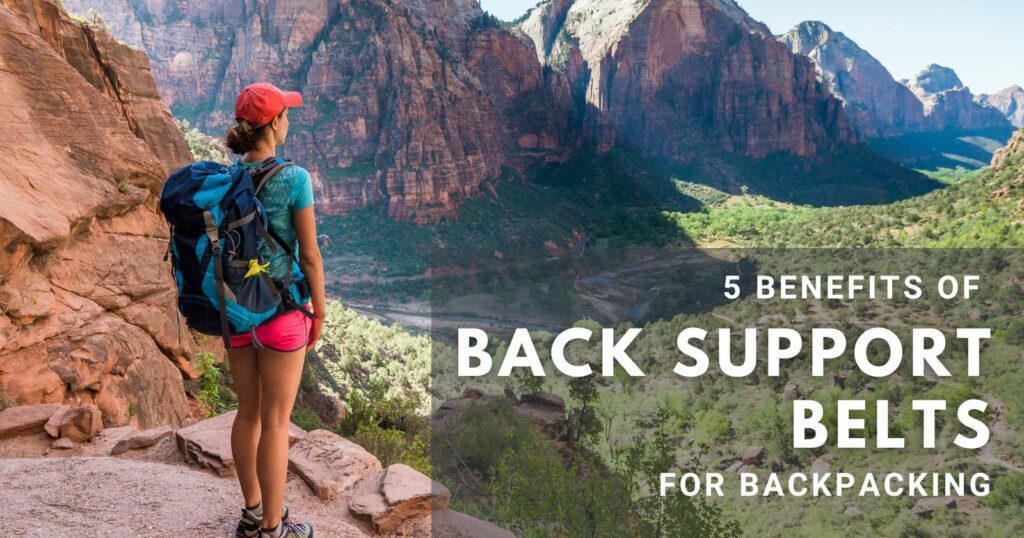Last Updated on 28 June 2024 by Cycloscope

Discover the advantages of using back support belts/brace while backpacking: improved posture, reduced strain, enhanced comfort, and pain prevention
Lower back pain is no stranger to most of us. It’s almost like an unwelcomed guest that often shows up after a long day at work, an intense workout, or a strenuous outdoor activity like backpacking. For those dealing with this aching discomfort, a back support belt often provides much-needed relief. This article centers around the benefits backpackers can reap from a back belt.
The Role of a Back Support Belt in Backpacking
Backpacking is an intense physical activity. It often involves long walks, climbs, and navigations through various terrains, all while carrying a heavy load on your back. This weight, even if packed well, can place a significant strain on your lower back, leading to discomfort or pain.
The weight from these loads is often exerted on one’s spine, leading to uneven distribution of pressure on the vertebrae and intervertebral discs. Consequently, this could exacerbate existing back conditions or even trigger new ones.
This is where the versatility of the support belt comes into the picture. Designed to reinforce the vertebrae and discs with added support, it can significantly alleviate the hardships caused by backpacking. This support also discourages unnecessary movements which can be detrimental to spinal health while promoting a more ergonomic body posture at all times.
check also
> 10 Best Sunscreen for Backpacking & Cycling
> The Best e-Bikes for Hunting
Benefits of Wearing a Lower Back Support Belt
1. Controlling Motion

One key advantage is immobilization. When we engage in physically intensive activities, like hiking, certain movements can exacerbate existing discomfort or provoke unwanted injuries. By carefully limiting these unnecessary movements with its constraining design, it often proves instrumental in offering relief and preventing further back discomfort.
2. Posture Improvement
Ensuring proper posture is not just about standing tall and looking confident. It holds immense importance for spinal health. Unfortunately, the benefits of maintaining good posture are often overlooked. A back belt serves as a constant reminder to hold your body accurately, ensuring your spine retains a healthy and naturally beneficial alignment even when you’re on the move, thus contributing to better postural habits.
3. Pain Prevention
One of the significant benefits a lower back support belt brings to the table is its stellar ability to prevent pain. By restricting potentially injurious movements, it helps avoid muscle strains and ligament sprains, two common issues that lead to back pain. This promise of pain prevention often lets you enjoy activities without worrying about the sinister sneak of impending pain.
4. Augmenting Support
A back brace isn’t just about prevention and restriction; it offers much-needed support too! It provides reinforcement to your spine, discs, and vertebrae, acting like a safety network to your back. Whether it’s easing the load on your spine while you carry a heavy backpack or providing a gentle reminder to straighten your back as you sit down to rest, a back brace comes in handy in more ways than one.
Factors to Consider in Selecting the Right One
Embarking on a hiking journey with an ill-fitting belt invites discomfort and potentially negates the benefits. Herein lies the need for a quality one – one that fits well, stays in place, does not chafe, and contributes to a comfortable hiking experience. A lumbar back support brace that aligns with your body shape and size will ensure effective immobilization and necessary support. Also, it should not be constrained to the point of restricting circulation. Overall, comfort is king when it comes to choosing a belt.
While broadly considering comfort, a selection of factors come into play:
- Flexibility: Depending on your trial and purpose, you must choose between rigid and flexible belts. The former offers higher restriction levels and support, while the latter allows more freedom of movement;
- Breathability: Depending on the climate or your personal preference, a breathable belt can improve comfort, making the belt more wearable during long hikes;
- Support for varying loads: Consider one that provides suitable support against the weight of heavy backpacks and can adapt to different loads you might encounter on various trips.
The correctly chosen lower back support belt can not only ease your hike but may also protect you from potential injuries, making it a vital piece of equipment in your backpacking gear. So, invest time, do your research, try the options, and make an informed choice. Remember, the goal is to enhance, not impede, your backpacking experience. Choosing the right lower back support belt, such as the one found at Nigex, can truly make a difference in your outdoor adventures.
How to Use It Correctly
Just as important as choosing the right one, is understanding how to put it to proper use. Here are some guidelines.
Optimal Hours for Wearing
When it comes to the daily hours for wearing a back belt, more isn’t always better. It’s recommended that advice be sought from a healthcare professional – usually, wearing the brace for the time you are engaged in activities straining your back is a good general rule. Immediate removal should occur once signs of discomfort emerge.
Tips for Correct Usage
There’s no one-size-fits-all approach to wearing a back belt. The nature of the condition, your body type, and specific activity levels are all variables affecting how you should wear it. However, some universal tips help ensure correct usage:
- Align Correctly: It should parallel the contours of your body, with correct alignment being key to the relief it provides;
- Ensure Comfortable Tightness: Your belt should be snug, but not to the degree that it restricts blood flow or causes discomfort;
- Layer Up: To avoid skin problems, wear a thin layer of clothing beneath your belt.
Long-Term Usage: Observing Caution
Long-term usage of a support belt without professional consultation is not advised. Extended periods could lead to muscle atrophy, a condition where muscles weaken due to lack of movement. Interrupted usage, complemented by strength-building exercises, helps maintain muscle condition while still providing the beneficial support the back belt offers.
Remember, a belt functions as a support mechanism, not a cure or permanent solution for back pain. It’s prudent to consult a healthcare provider periodically to evaluate your back condition and adjust belt usage accordingly. The aim is to strike a balance between relief and reliance to fully enjoy your backpacking adventures.
check also
> The Best Knives For Backpacking, Bikepacking, Hiking, and Camping
> The 11 Best Base Layers for Cycling in Winter
Other Treatment Options and Preventive Measures
While a lumbar back support brace provides valuable support, it’s just one piece of the puzzle in managing back health – especially for backpackers who may be constantly challenging their physical boundaries.
Combining Methods
The use of a belt, when harmonized with an active lifestyle comprising regular exercises and sound ergonomic practices, creates a holistic approach to spinal health. Pressure is relieved from the intervertebral discs through the belt’s immobilization while exercises aim at strengthening the muscles around the spine, thereby providing natural support.
Ergonomics also plays a significant part. From the way one lifts their backpack to the posture maintained during a hike, every movement impacts spinal health. Pairing these methodologies with the advantages offered by a lower back support belt can create a substantial difference.
Aiding Pain Alleviation
To bolster spinal health further, other methods can be leveraged:
- Strengthening Exercises: Certain workouts target the muscles enveloping the spine. Strengthening these muscles helps improve posture and support the vertebrae and discs, ultimately reducing pain;
- Postural Corrections: A prominent cause of back discomfort is poor posture. The practice of maintaining a proper posture – sitting upright, standing straight, or even sleeping in a correct position, can remarkably relieve back tension and pain;
- Maintaining a Healthy Weight: Obesity or being overweight can also contribute to lower back discomfort as it places unnecessary strain on the spine. Therefore, observing a healthy lifestyle to maintain an ideal weight can ease the pressure on your back, thus contributing to lesser pain.
In essence, It functions as a reliable tool, but relying solely on it might not be beneficial in the long run. Building a more comprehensive approach involving exercises, lifestyle modifications, and preventive measures can promise a healthier spine and more enjoyable backpacking experiences.
Summary
To conclude, wearing it during backpacking can tremendously facilitate an enjoyable outdoor journey by preventing, managing, and reducing lower back pain. However, while this article emphasizes the benefits of a belt, it’s important to remember that persistent back pain must not be ignored. Seeking professional medical advice is highly recommended in such scenarios.
Beyond just wearing a back belt, every avid backpacker should explore holistic treatments and preventive measures to maintain overall spinal health. After all, backpacking should always be about fulfilling adventures, not about dealing with persistent backaches!


